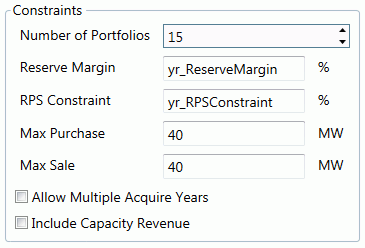Portfolio Constraint Settings
Use these settings to apply constraints to the optimization.

Click on the following General options listed here to see the dropdown descriptions:
|
Number of PortfoliosNumber of Portfolios This defines how many portfolios on the efficient frontier the optimization will produce. An entry of 1 will cause the model to only calculate the least cost portfolio and ignore the risk metric. Otherwise, the optimization will calculate the least risk and least cost portfolios with the remaining number of portfolios in between along the efficient frontier. Reserve Margin (%)Reserve Margin (%) This is the percentage reserve margin requirement for the portfolio. It can be entered as a fixed number or as a reference to the Time Series Annual table. If possible, the model will ensure that in the portfolio chosen, the sum of the (Expected Capacity)*(Peak Credit) for each year will be greater than or equal to (1 + [Reserve Margin]/100)*(Expected Peak Demand). To make this constraint non-binding, set it equal to -100.
Optionally, this field can also specify a maximum constraint that the reserve margin cannot exceed. In this case, two inputs can be entered as a comma delimited list. The first input represents the minimum % value, and the second input represents the maximum % value. If a second input is not entered then Aurora will consider it unlimited. Both values can be entered as either a time series or a fixed number. For example, an entry could be "yr_MinReserveMargin, yr_MaxReserveMargin". RPS Constraint (%)RPS Constraint (%) This is a percentage of demand which must be met by owned RPS generation. Use the RPS column of the Portfolio Optimization input table to specify that a resource's generation can contribute to this constraint. This value can be entered as a reference to the Time Series Annual table. Optionally, this field can also specify a maximum constraint that RPS generation cannot exceed. In this case, two inputs can be entered as a comma delimited list. The first input represents the minimum % value, and the second input represents the maximum % value. If a second input is not entered then the model will consider it unlimited. Both can be either time series or numeric. For example, an entry could be "yr_MinRPS, yr_MaxRPS".
Max Purchase (MW)Max Purchase (MW) The MW amount which represents the maximum market purchases which can take place to meet the demand for the portfolio. The numbers should be entered as positive amounts. Valid entries include Time Series Annual and Time Series Monthly inputs. Aurora will take this input and multiply it by the number of hours in the time bucket to get the maximum MWh that can come from the market. For example, if the time period was month, the entry here was 100 MW, and there were 544 on-peak hours in January, then the MWh purchase limit for the on-peak January time bucket would be 54,400 MWh.
The MW amount which represents the maximum market sales which can take place to meet the demand for the portfolio. The numbers should be entered as positive amounts. This works in the same manner as the Max Purchase constraint (above). Valid entries include Time Series Annual and Time Series Monthly inputs.
Allow Multiple Acquire YearsAllow Multiple Acquire Years This option will enable the resource options or contracts to be acquired in years other than their begin year. The span of years that resources will be available to be acquired is defined in the Portfolio Optimization input table.
For example, suppose that in an optimization study from 2015-2025, a resource had a First Acquire Year of 2015 and a Last Acquire Year of 2025. The model would create eleven versions of that specific resource. Each of these resources would contain values of 0 for all parameters (cost, generation, capacity, etc.) for time periods prior to the resource acquire year. The model could then choose to acquire the whole resource in one specific year, or it could acquire the resource gradually over more than one year. The total percent acquired for the resource by the last year of the optimization would not be more than the input Upper Bound or less than the Lower Bound. Include Capacity RevenueInclude Capacity Revenue This switch determines whether capacity revenue and the cost of capacity demand will be accounted for in the optimization. If selected, the capacity revenue for each resource will be a part of the total portfolio cost calculation. A capacity cost will also be calculated based on the annual peak demand and the capacity prices. If this is not selected, it will be assumed that no resources receive revenue for capacity and that the portfolio does not have any capacity costs to pay. |
![]() Portfolio Constraint Settings
Portfolio Constraint Settings
